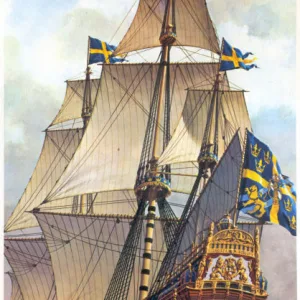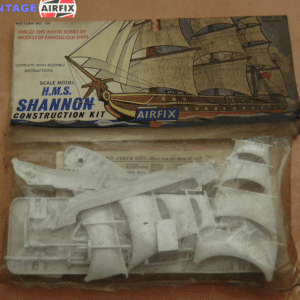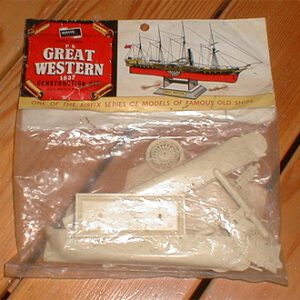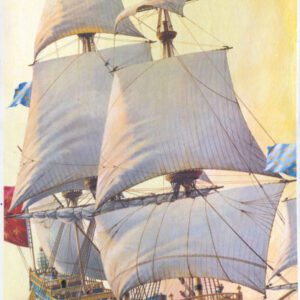Description
'Mutiny on the Bounty' is one of the most chronicled sea stories in history. At the end of 1787 Lt. William Bligh, a seaman of considerable experience, was sent to the Pacific in command of HMS Bounty, a merchantman converted by the Royal Navy for carrying breadfruit trees from Tahiti to the West Indies. On April 28, 1789, when the ship was near the Friendly Islands, the crew mutinied against Bligh's severe command. Led by the master's mate, Fletcher Christian, the mutineers took over the ship and set Bligh and 17 others adrift in a 23 ft open launch. The mutineers themselves went to Tahiti and on to Pitcairn Island and settled there, some later being captured and returned to Britain for trial. Bligh and his companions eventually landed at Timor in the East Indies, having made an epic voyage of nearly 4,000 miles. He returned to England in 1790, and ultimately introduced the breadfruit tree into the West Indies.
The Bounty began life as the Bethia, a bluff-bowed merchantman. She was purchased by the Admiralty in May 1787 and taken to Deptford for modification to carry breadfruit plants. For defensive purposes, the ship was equipped with four short 4-pounder carriage guns and ten half-pound swivel guns mounted on the hull. The ship accommodated a crew of 45 and carried three boats, the famous 23 ft launch, a 20 ft cutter, and a 16 ft jolly boat. Admiralty records show that the ship's wooden sheathing boards protecting her hull below the waterline were removed when in dock and replaced with copper. She had a total of five anchors, two large ones carried at the catheads, and three more stowed in the hold. To carry the breadfruit plants, the entire lower deck from the after hatchway to the stern was converted into store. The deck was covered with lead as a means of preserving fresh water used to care for the plants. The captain's cabin was situated on the port side of the lower deck and the sailing master had an identical cabin on the starboard side. Few illustrations exist for the Bounty as her one and only voyage was when she sailed for the Pacific. However, the admiralty produced sets of drawings when the ship was at Deptford and her overall dimensions according to these diagrams show she had an overall length of 104 ft 9 in and a breadth of 24 ft 3 in. – Taken from the 17th edition catalogue (1980)
1982 edition catalogue, listed as H.M.S. Bounty from HMS 'Bounty'.
1987 edition catalogue, listed as part of the Classic Ships Special Editions range.
1987 edition catalogue, listed as Bounty from H.M.S. Bounty.
1993 edition catalogue, listed as HMS Bounty 1787 from Bounty.
1994 edition catalogue, listed as HMS Bounty from HMS Bounty 1787.
Additional information
| Airfix Series (first appearance) | 9 |
|---|---|
| First Issued | 1979 |
| Catalogue Ref - 17th Edition (1980) | 09259-7 |
| Catalogue Ref - 1982 Edition | 09259-7 |
| Catalogue Ref - 1987 Edition | 9259 |
| Catalogue Ref - 1988 Edition | 9259 |
| Catalogue Ref - 1989 Edition | 9259 |
| Catalogue Ref - 1990 Edition | 9259 |
| Catalogue Ref - 1992 Edition | 9259 |
| Catalogue Ref - 1993 Edition | 9259 |
| Catalogue Ref - 1994 Edition | 9259 |
| Catalogue Ref - 1995 Edition | 9259 |
| Catalogue Ref - 1996 Edition | 9259 |
| Catalogue Ref - 1997 Edition | 9259 |
| Catalogue Ref - 1998 Edition | 9259 |
| Catalogue Ref - 1999 Edition | 9259 |
| Catalogue Ref - 2000 Edition | 9259 |
| Catalogue Ref - 2001 Edition | 9259 |
| Catalogue Ref - 2002 Edition | 9259 |
| Catalogue Ref - 2003 Edition | 9259 |
| Catalogue Ref - 2004 Edition | 9259 |
| Catalogue Ref - 2005 Edition | 9259 |
| Catalogue Ref - 2006 Edition | 9259 |
| Catalogue Ref - 2007 Edition | 9259 |
| Catalogue Ref - 2008 Edition | A09259 |
| Artist on Box Type 6 | Geoff Hunt |










